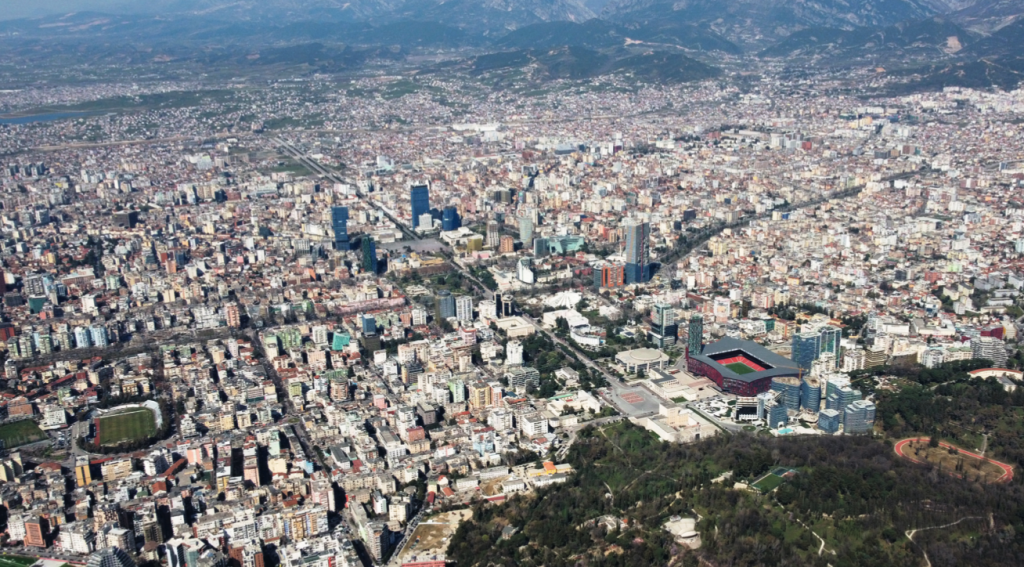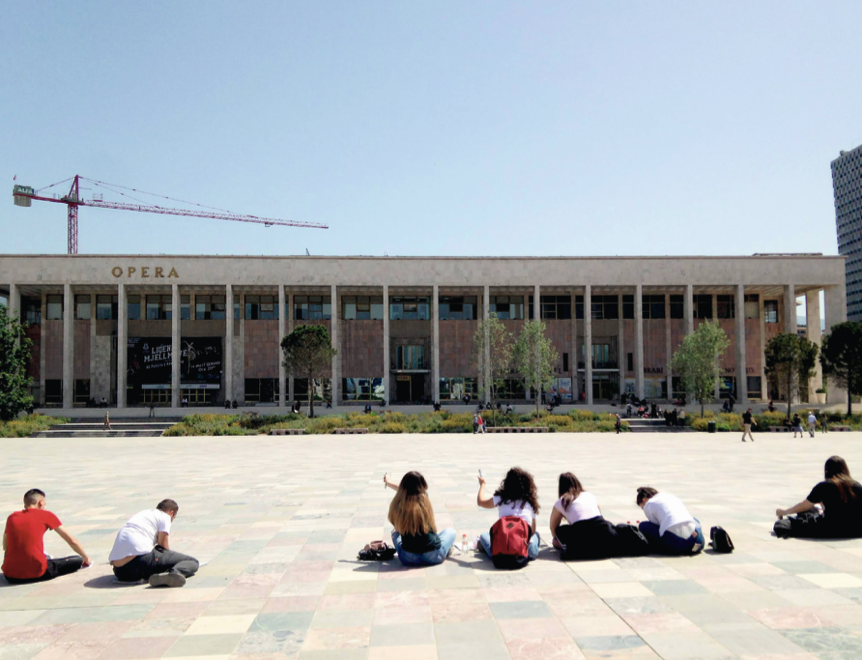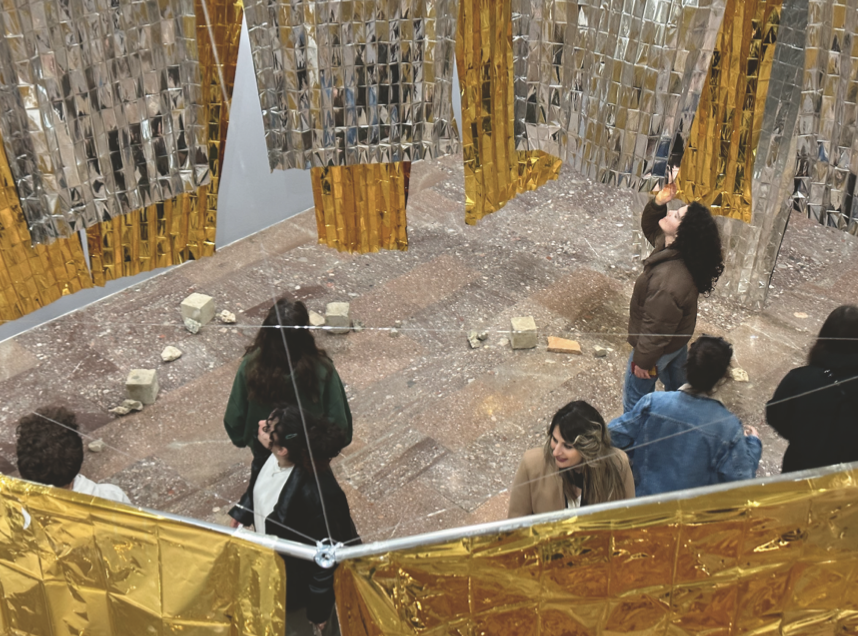Interview with Saimir Kristo
Saimir Kristo is an architect and urban designer, currently founder of the Architecture Fund in Albania and also Deputy Dean and Lecturer at the Faculty of Applied Sciences and Creative Industries at BARLETI University. He is the founder of IXI Architecture, an award-winning architectural practice in Albania. His cultural contribution to the profession includes being a founder of the Architecture Fund in Albania (AFA), and initiator of the activities of the first Tirana Architecture Triennale and Open House Tirana.
As an active member of civil society, he engages with communities to develop a common educational platform in the field of architecture and urban planning. He holds a PhD in architecture and urban planning, with his work focused on city morphology and urban catalysis and their role in the trans- formation of public spaces, research that is a result of his experience as a project leader of many urban regulatory plans in Albania. His scientific activity includes with mono- graphs and publications, as well as work as a jury member in various international competitions. He also serves as an Inde- pendent Nominator for the EU Mies van der Rohe Award, as appointed by the Fundacio Mies van der Rohe for Albania. Since its establishment, he has been a board mem- ber of the Fundjavë Ndryshe philanthropic foundation.

Tirana aerial view. Photo: © Open House Tirana
How Tirana changed in the last 20 years?
With regard to the weather, it was much rainier. It used to be the rainy city in Alba- nia 20 years ago, when I come back from Greece. It changed radically in other ways, too. In 2004 there were not even proper bars. Of course nobody cared about bars at the time, as the country was just coming out of a difficult period from the civil war in 1997, where pyramid schemes tricked many people and took their money. Fifteen years ago I was not really sure if we would be able to escape from this closed territorial system, but today we face a different prob- lem, that people are leaving, with massive waves of emigration. The problem I’ve faced as an individual but also as an architect in the last 20 years has been working in re- mote areas of Albania. When I first came back there was this amazing energy where people wanted to change the country, they wanted to escape from those enclaves, from the past. There were many cases of informality in the 1990s, many cases of wild development, but there were also people with amazing energy. Whenever we had problems we could always solve them, be- cause there were enough people and there was enough energy. This was even true if you went to the rural areas of Albania. Lively villages were very much present in the land- scape of the county, but today are almost empty. Villages that once had a thousand inhabitants now have only 13. The desire to move into big urban centres in the 1990s was very strong, and so huge numbers of people left the countryside. And it’s still happening today. When I moved to Tirana there was only around half a million people, and now there’s a million. So of the two and a half million Albanians who have left their villages and small towns, about one million now live between Tirana and Durrës, the main port city. Meanwhile, the whole coun- try is around 29,000 km2. These migrations are very important when we speak about how Albania changed.
So architecture is not the central thing when we think about what has changed?
I think it’s hardly about the architecture at all. Architecture is a way to justify, to cam- ouflage, to improve and to manifest things that people are much more sensitive about. It is a means to deconstruct mentalities but also a means to educate people, to improve their surroundings and create a common language of living, of being. All these years of architecture in Albania have not been about the use of innovative ap- proaches, but instead a way to change the identity of the city, of Tirana. I have a very clear image in mind, from 1990 when the main Skanderbeg Square had only pedes- trians, only one bus and one truck. People thought we had a very organised square with the right amount of people – whatever that means – and public transport with one bus. Now what if went back to this situation? That could be very dangerous, because the reason why there were no cars in Skander- beg Square wasn’t because people didn’t want one, but because they couldn’t have one. People also didn’t feel that the square was a real public space, as it was really the main space for the propaganda of Hoxha’s authoritarian regime. Today’s public spaces might seem like they’re organised in a more contemporary way, but they are still made only for events, either a political meeting, music concert or sporting event. The real life happens in such squares after midnight or in the early morning, where there is no urgent need to be there but people go out of pure pleasure or desire. Architecture was and is still used to express political domi- nance and authority. To have a beautiful architecture we have to present it properly and experiment. But I don’t like to use the word educate in this context, and think it’s better to think about developing relation- ships of co-ownership with regard to proj- ects that people really want.

Tirana New Boulevard. Photo: © Open House Tirana

Skanderbeg Square during daytime. Photo: © Open House Tirana
That said, as an educator you work in an educational institution. How is the edu- cational system in Albania functioning with regard to architecture?
Unfortunately it’s based on a dogma of the repetitive reproduction of earlier projects, and so students tend to limit their creativity because of the restrictive educational sys- tem. This is a problem for all of us working in education, something we have to change, as we continue to teach students what we were taught 20, 30 years ago. We need to change things radically, and also stress the importance of reading, of encouraging students to go in depth in their studies of certain ideas. Then they can find the right tools to express themselves better. And to achieve this we professors also need to edu- cate ourselves more, read more and listen more. This is the problem with architects in Albania – they don’t listen so much but tend to speak a lot. Another issue in this context, one which I am very critical about, is unpaid work, which has now become normalised. We need to teach students to be aware of how much they need to be paid, so they can value their work. Such things are rarely, if ever, talked about in class.
Maybe LINA is the good opportunity for that. Can you tell us what LINA created for Barleti?
Some of our LINA fellows have pushed for- ward the ideas of inclusivity and education, which makes me very proud. For Barleti, the LINA collaboration has been very important for bringing fresh ideas from incredible fel- lows with a high level of integrity and profes- sionalism. Moreover, this work encouraged our students to consider such topics and collaborate with the others. It is often sim- ply a case of feeling able to ask a question in class without being judged for it. If you can then understand that other people are interested in the same question, then you immediately feel that you are part of a com- munity. Another important issue here is the continuous collaboration with other institu- tions that are part of LINA. I have always seen this as something more than a Euro- pean project with regard to architecture, because it extends beyond Europe. The international collaboration that takes place in this context can not only support existing projects, but can also be used as a means to go further, to look beyond and investigate some very complex problems. Last year we had an opportunity to host the New South collective and consider the issue of sacred grounds. In Albania there is a problem with different ideas co-existing, although we have four different main religions in the country. When Albania was a dictatorship religion was essentially banned in the 1960s, so now we need to find a new, common language that will let all these faiths live together. The New South’s installation in the National His- torical Museum, the most dictatorial building in Albania, presented all four religions and created a non-physical temple for their fol- lowers inside an extremely dogmatic build- ing. In projects like this we try to touch not only the built aspect of the space, but also how we perceive the space.

Urban Streetscapes: Filter Café Filtré. Photo: © Tirana Architecture Triennial

Skanderbeg Square changes its identity during the evening. Photo: © Open House Tirana
What can you say about the demolishing of the National Theatre of Albania that happened few years ago?
This was a collective act. It was not just an act to build a new theatre. It was not only an act by the government to transform a public space, get rid of the old building or neglect its value. I think it was an act of all of us as architects, as citizens of Tirana, when we chose not to draw attention to all the other historic buildings that have been left to the mercy of time for the last three decades. It is something we need to reflect on. We might not have the money to restore such buildings, as culture is the smallest portfolio in our government, but we have to ask for more. And this kind of demolition is not rare. What happened with the theatre has hap- pened and continues to happen with hun- dreds of historic buildings in Tirana and all around Albania. We always get involved at the last moment, when we know that there’s almost no to do anything. We should em- phasise the importance of these buildings and find a way to restore them, because the city of 20 years ago it’s not recognisable today. At 4:30 in the morning on the 17th of May 2020 the theatre was demolished, and that was not the moment to ask for the old building to be rebuilt, but instead a moment to recognize how neglectful we are as a society and how important is to turn our at- tention to the city that we are just taking ad- vantage of. The memory of the city is always important, and we need to be able to pass on the memory of this historic theatre to the next generation, and not to romanticise the idyllic idea of a nice, new theatre. It is impor- tant to show the identity of our city – how it was and how it has changed.
How do you see architecture in the future?
Beautiful! Why not? I am not part of the dra- matic and pessimist discussions which insist that architecture and our cities are getting worse. We have students who are not com- promising with regard to their ideas, and they want to make changes for the better. I want to welcome such developments, and see myself as part of this evolving system. I think with today’s students soon working in the field of architecture we have a bright future. What we need to do is embrace new ideas, to feel them. We have to open our minds and to wake up. We have to keep the dreams of our inner child alive, and those of us working in architectural education are responsible for encouraging all our young students to keep their own dreams alive, and to then realise them.

Roundtable Virtual or Physical; from left to right Etleva Dobjani, Saimir Kristo, Dijana Vučinić, and Tinatin Gurgenidze. Photo: © Tirana Architecture Triennial

Space Saloon + The MAAK. Photo: © Tirana Architecture Triennial

Northern Boulevard Extension. Photo: © Open House Tirana

Sacred Grounds by New South. Photo: © Tirana Architecture Triennial
Written by:
Boštjan Tadel
Text: Boštjan Bugarič
Photographs: Kristiana Meço, Open House Tirana, Tirana Architecture Triennial











